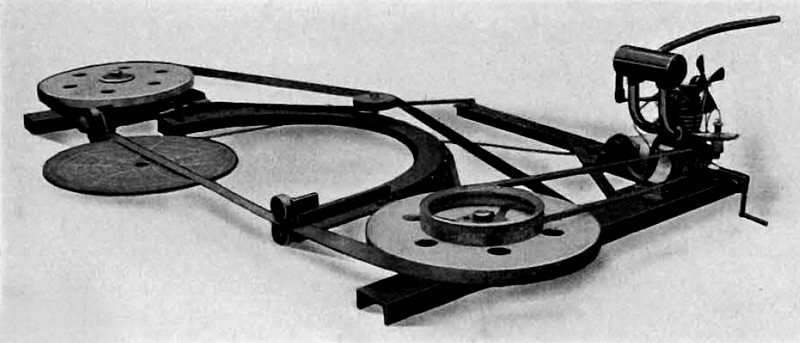|
Title: |
1926 Article-John Pickles, & Son, Bandsaw for Felling Trees & Cross-Cutting Felled Logs |
|
Source: |
The Engineer Magazine, 02 Jul 1926 pg. 19 |
|
Insert Date: |
6/13/2013 8:54:46 PM |
A Tree-felling Band Saw.
We have received from Mr. John T. Pickles, of Mytholm House, Hebden Bridge, Yorks, some particulars and illustrations of a new form of tree felling saw, which he has recently produced, that embodies a rather novel feature.
Reciprocatory saws have, of course, been used for tree felling for many years past and, in their way, are most effective, but a engineer only naturally prefers to employ a continuous motion rather than a reciprocatory one. For this reason, Mr. Pickles has adopted a band saw and has overcome the objection, which would otherwise arise, of the saw making two cuts across the tree by twisting the saw on itself through a right angle.
On reference to our engravings, it will be seen that the saw is normal to the exent that it runs over two pulleys—they are aluminum castings—fixed in a frame, which is bowed to accommodate the girth of the tree to be felled.
A jockey pulley on a spring-controlled lever is provided to keep the saw in tension, and one of the main pulleys is driven by means of a vee belt by a 3½ horsepower air-cooled petrol engine. The pulleys are fixed in a frame lying in a horizontal plane, and the saw is presented in such a manner that it can make a horizontal cut by twisting it along the working length through a right angle. This twisting, it will he seem. is effected by two pairs of rollers mounted on extensions of the U-shaped frame. The consequence is that the saw ran make a cross-cut which is only limited by the capacity of the frame and, in the case of the
machine illustrated, it will go through a tree 4ft. in diameter. The U frame is pivoted to a channel iron base at the centre of the saw pulley in the foreground, and the whole arrangement is fed into the cut by means of a. wire rope spiked to the tree stump, running over a pulley on the frame and wound on to a little hand winch, which can be seen just behind the engine.
The saw itself. which is 1½in. wide and rather thin, so that it may readily accommodate itself to the twisting process, runs at a speed of from 3000ft. to 4000ft. per minute and will, we understand, go through a tree 3ft. in diameter in from two to three minutes. It ran also cut as close to the ground as 6in., so that a considerable amount of timber can be saved, as compared with the usual hand practice of felling trees breast high.
By erecting the framing on edge, as shown in our second illustration and appropriately re-arranging the engine, the saw can be used for cross cutting felled logs, while it can be mounted on in traveling trolley and used to convert them into scantlings. The total weight of the machine is approximately 5 cwt.., and the heaviest, single piece weighs I20 lb.
The Engineer magazine courtesy of Grace's Guide
http://www.gracesguide.co.uk/The_Engineer_1926/07/02 |
|
 1926 John Pickles, & Son, Bandsaw for Felling Trees & Cross-Cutting Felled Logs
1926 John Pickles, & Son, Bandsaw for Felling Trees & Cross-Cutting Felled Logs
 1926 John Pickles, & Son, Bandsaw for Felling Trees & Cross-Cutting Felled Logs
1926 John Pickles, & Son, Bandsaw for Felling Trees & Cross-Cutting Felled Logs
|
|